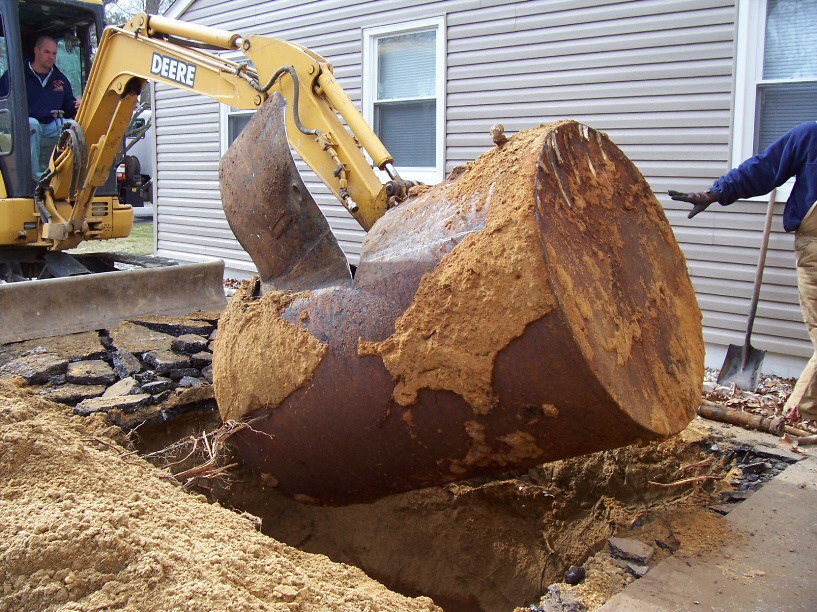 |
Call us today for oil tank removal.
|
Oil Tank removal services Mississauga, Oakville, Burlington, Toronto, Etobicoke, Scarborough, Orangeville. (416) 402-8295 We do oil tank removals.Having abandoned water tanks, fuel tanks, oil tanks,and other types of tanks that you need to remove, call us today. We takeaway dispose and remove above ground tanks as well as underground fuel storage tanks from your homes, farm properties and commercial property. Some type of tank removals we do in Canada. Tanks from gas stations Fuel tanks from farms Old water tanks from farm properties. Oil tanks used in the industrial sector such as holding tanks for oil, orb antifreeze. Tanks put underground and buried, such as gasoline storage tanks, water or other fuels,. Above or Underground/below ground, Residential oil Tanks and other types of holding tank containers. Both commercial and of course residential tanks.
Here's what to expect when Homepros group Oil Tank Removal companies comes to remove your above ground or buried oil tank:
Hamilton
Dundas
Ancaster
Aldershot
Binbrook
Burlington
Mt. Hope
Stoney Creek
Carlisle
Oakville
Bronte
Halton
London
Brantford
Guelph
Kitchener
Waterloo
Cambridge
Toronto (GTA)
Richmond Hill
Mississauga
Brampton
Markham
Etobicoke
Brampton
Vaughn
Caledon
Pickering
East Gwillimbury
Whitechurch
Stouffville
Uxbridge
Georgina
Scarborough
Clarkson
Mimico
North York
Malton
Streetsville
Port Credit
Caledonia
Cayuga
Dunnville
Hagersville
Long Point
Pt. Rowan
Pt. Dover
Simcoe
Scotland
Grimsby
Beamsville
Winona
Niagara Falls
St. Catherines
Welland
TSSA,s involement with oil tanks and hazardous waste in Canada Who is TSSA? About TSSA Our Purpose To promote and enforce public safety. Our Vision To be a valued advocate and recognized authority in public safety. Company Profile Putting Public Safety First Since 1997, the Technical Standards and Safety Authority (TSSA) has delivered public safety services on behalf of the government of Ontario in four key sectors: • boilers and pressure vessels, and operating engineers; • elevating devices, amusement devices and ski lifts; • fuels; and, • upholstered and stuffed articles. TSSA is a not-for-profit, self-funded organization dedicated to enhancing public safety. With headquarters in Toronto, TSSA employs approximately 380 staff, 70 percent of whom work in operations. Governed by a 13-member board of directors, TSSA is accountable to the Ontario government, the residents of Ontario and its other stakeholders. TSSA funds its operations by charging its industry customers a fee for the services it provides. Safety Value Chain and Value Proposition While TSSA’s is required to enforce the Technical Standards and Safety Act and regulations, the organization has embraced a much broader role than compliance. Storage Tanks Hold More Than Just OilThere are a lot of misconceptions out there about heating oil tanks. You may think tanks are unsafe ... or that they're subject to legal issues. Educating new and prospective homeowners about the benefits of oil tanks will allow them to feel more comfortable when choosing an Oilheated home. Safety
Legal Issues
Convenience
Versatility
WHAT TO DO IF AN OIL TANK IS LEAKING Suspect a leak in an underground oil tank? Call a TSSA registered fuel oil contractor to help find and stop the leak and clean up any leaked fuel oil. In Ontario, homeowners are also required to call the Spills Action Centre of the Ministry of Environment at 1-800-268-6060. Insurance companies may also have resources of information. Underground tanks are required to be upgraded with specific leak and spill prevention equipment or be removed. WHAT TO DO WITH UNUSED UNDERGROUND OIL TANKS An unused underground oil tank must be removed and all contaminated soil must be cleaned. Underground tanks are required to be removed by TSSA registered fuel oil contractors. When an underground tank is removed, the soil around the tank must be assessed for contamination and all contamination cleaned. The following steps must be taken to decommission a storage tank:1. All remaining oil must be pumped out from the storage tank and connected pipes. 2. Sufficient holes are cut along the top of the storage tank to inspect the tank. 3. Any residual oil or sludge along the top of the storage tank must be removed. 4. The tank must be filled with an inert material such as low density concrete slurry mix, or sand/gravel. The access must be large enough to ensure the tank has been fully filled. 5. Associated piping shall be removed from the ground or purged of vapors and the ends permanently sealed by capping or plugging. 6. Written verification from a licensed contractor is required to the District Fire Inspector for work complete. 7. For your own protection, soil around the old tank site should be tested for contamination if contamination is found, you must contact the Environmental Protection Branch for instructions on how to replace soil with clean fill.Learn more Boiler & Tank removing services.Removal in OntarioHere is a list of areas our company can help with heating tank, and boilers. As your Ont. contractors our mission is to give our customers the best in customer service. Othe tank removal companies dare to compare. Testing soil after
|  |
